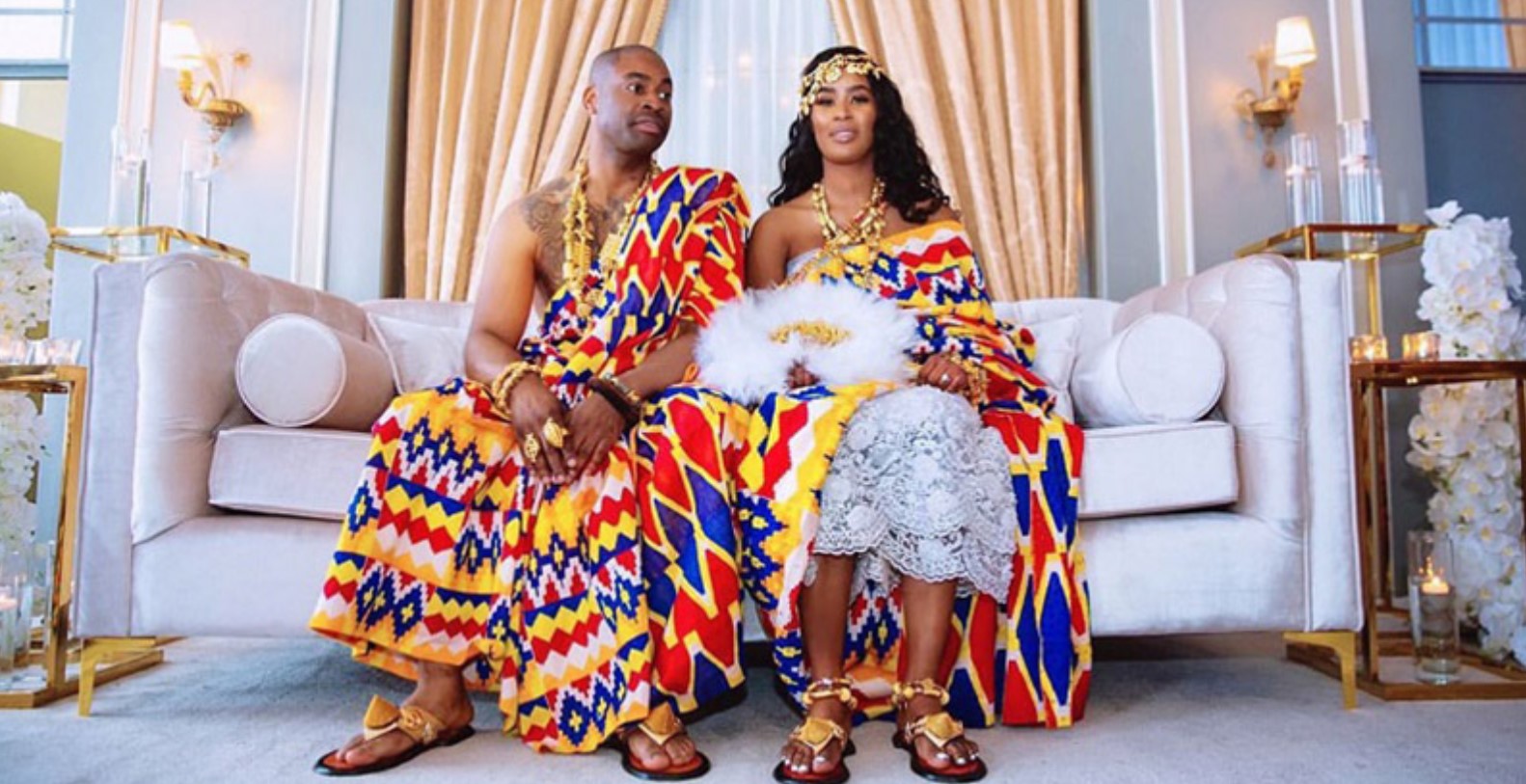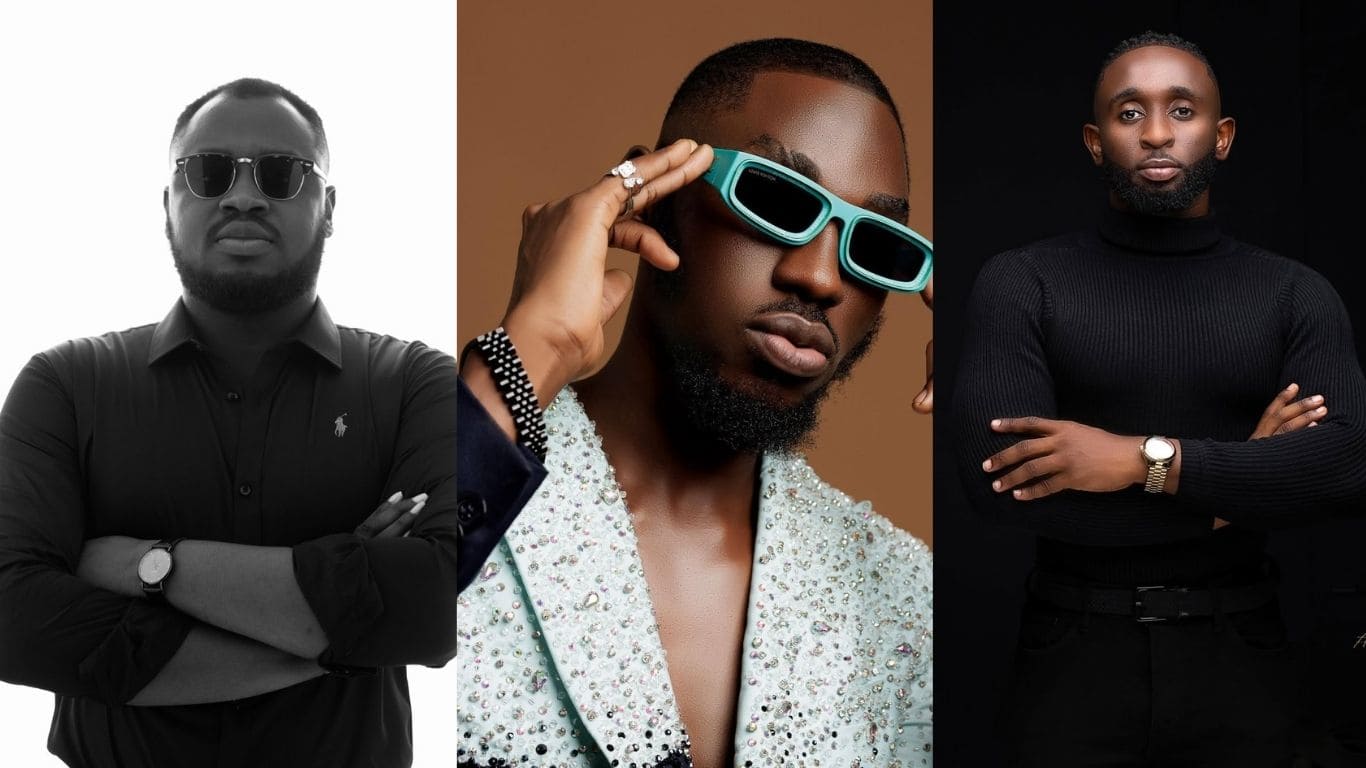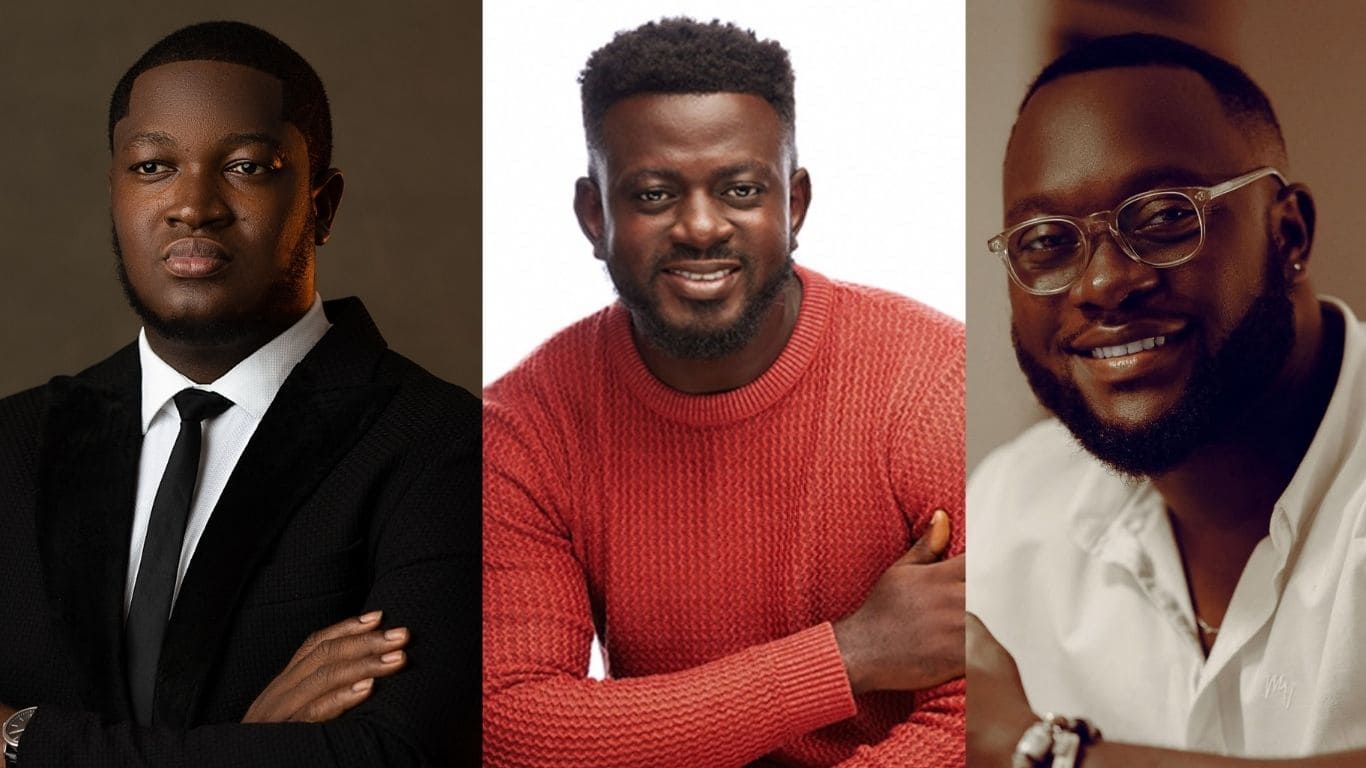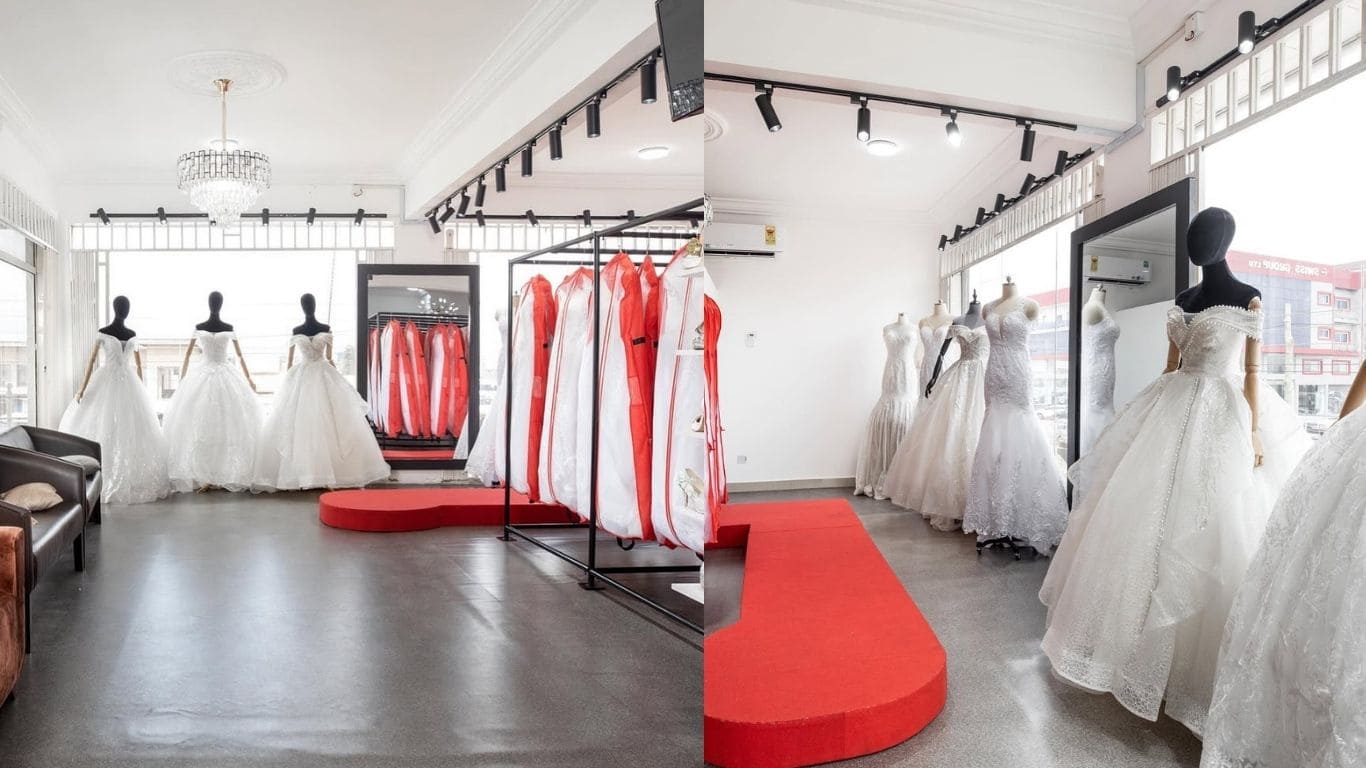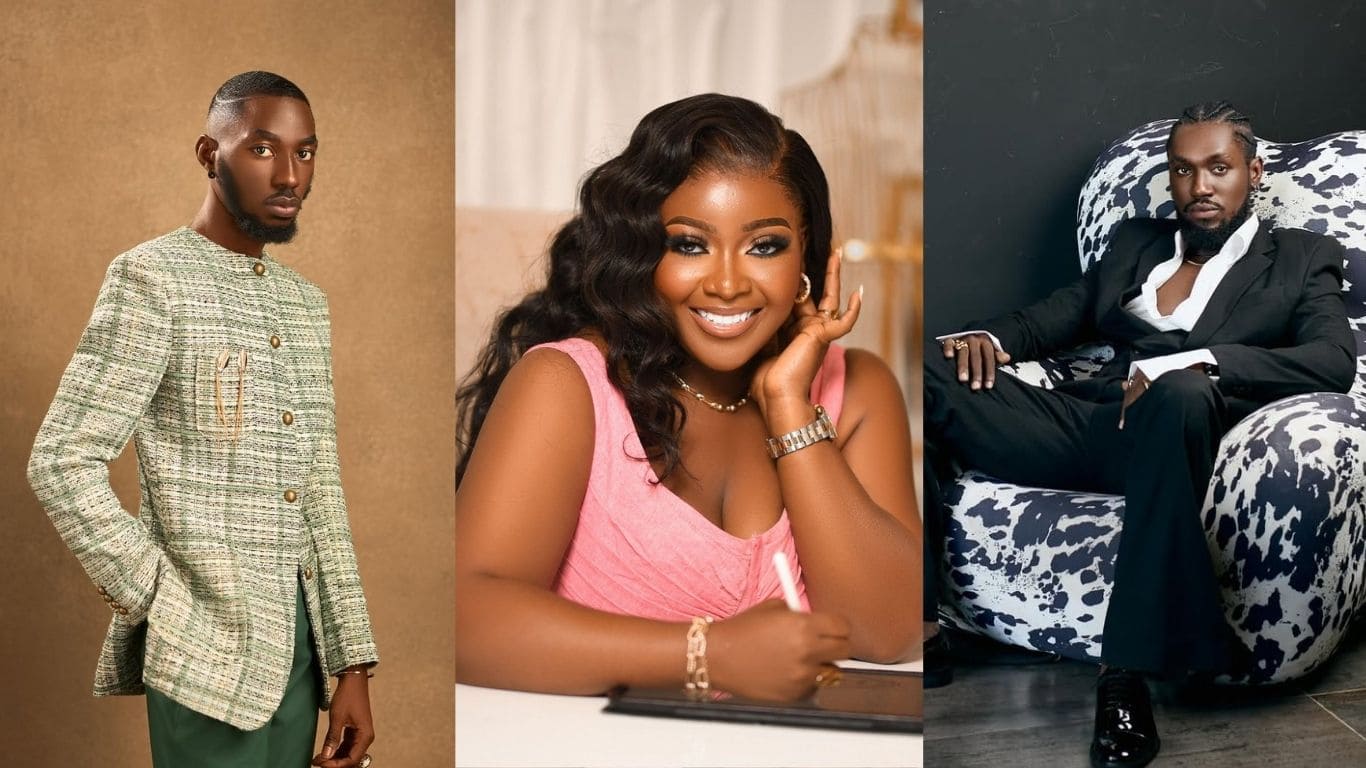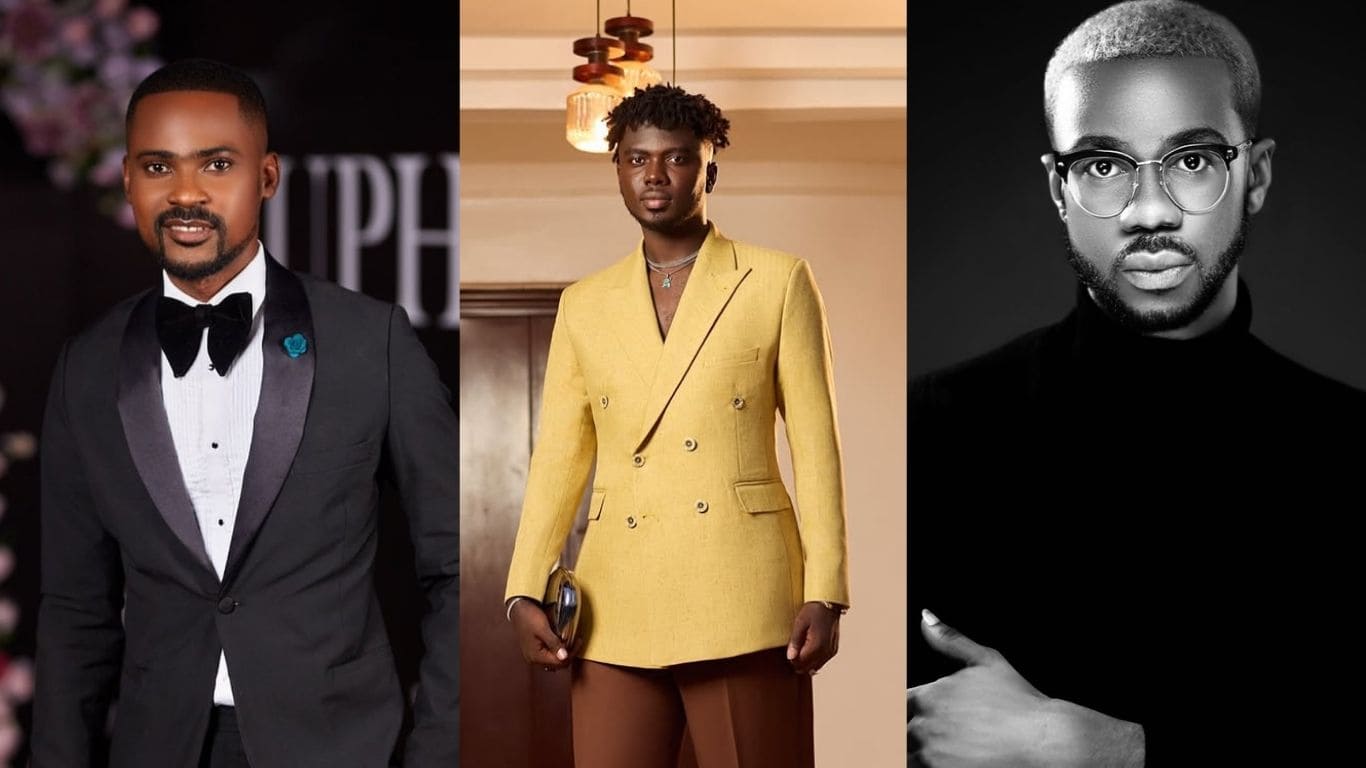Eager to know how Ghanaians dress for wedding ceremonies? Here’s an overall insight into what the couple, bridesmaids, groomsmen, and guests wear.
Gone are the days when couples, bridesmaids, groomsmen, and guests adhered to a single, uniform style of attire on wedding days. In the 21st century, the landscape of wedding fashion has evolved, embracing a rich tapestry of styles that reflect individuality, cultural significance, and personal expression.
This shift is particularly evident in the vibrant and diverse realm of Ghanaian weddings, where the attire of the bride, groom, and guests has become a canvas for storytelling and cultural celebration.
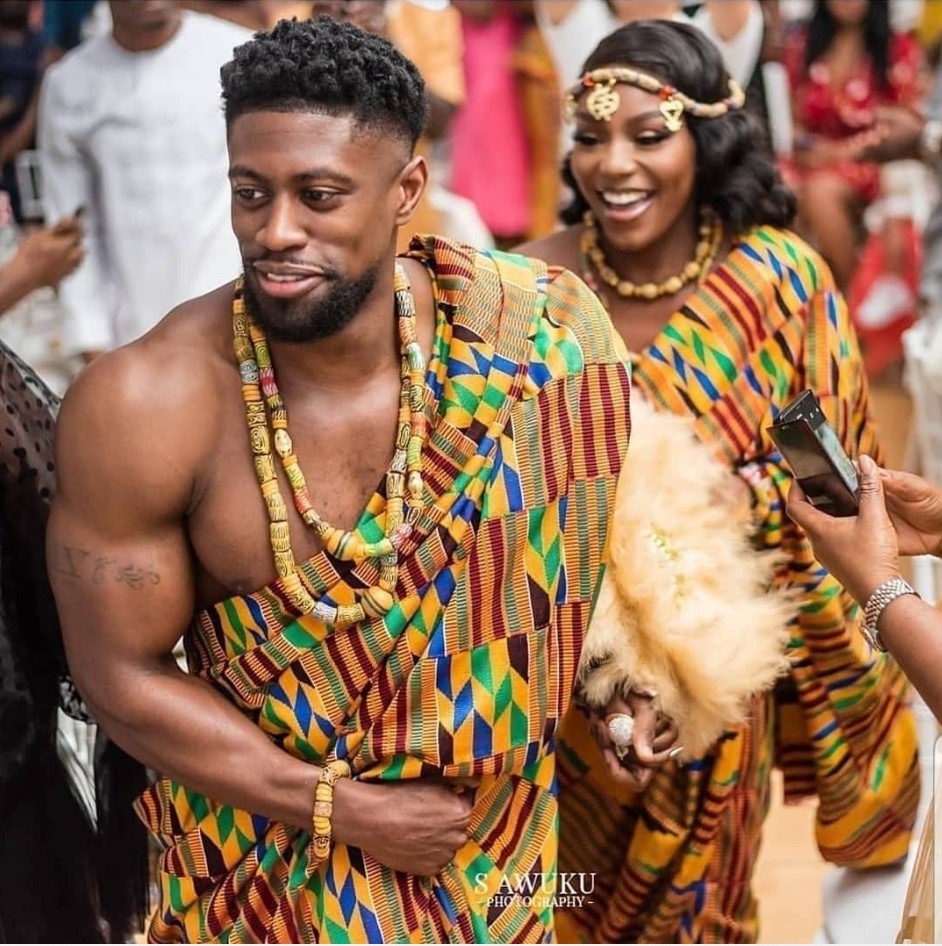
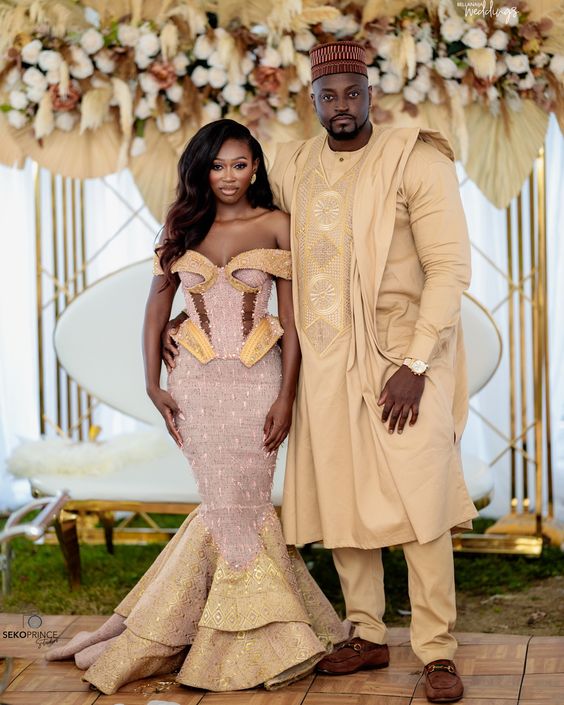
A General View of Ghanaian Wedding Attire
A typical Ghanaian traditional wedding seems to have a dress code in Ghana of late. Couples will dress in clothes that make them feel like royalty on their big day.
What is the name of the wedding dress in Ghana? Lately, almost every couple is going by the Akan traditional marriage ceremony attire code, where both the bride and groom adorn themselves in exquisite fabrics known as Kente in Ghana and as Kita cloth in Céte d’Ivoire.
The Kente cloth is made of handwoven silk and cotton. For the occasion, it is often brightly colored and patterned or embroidered, along with gold jewelry to accent the attire.
The Ghanaian traditional wedding dress is vibrant and colorful, covered with intricate designs. They are usually characterized by the following:
- Kente Cloth: Both the bride and the groom wear this exquisitely woven fabric, which comes in a plethora of colors and patterns, each with a distinct symbolic meaning. The bride can wear her kente as a gown or as two separate pieces, a top and a skirt, while the groom can wear his as a toga or as a wide-flowing rove known as an Agbada.
- Duku: This is a wrapped-up headscarf worn by the bride. It matches the color and fabric used to make the wedding dress.
- Embroidered Fabrics: Delicately embroidered fabrics are also used to make traditional wedding gowns in Ghana.
- The bride also wears a traditional headdress that resembles a crown, called a tekua.
Colors hold symbolic meaning for couples. For example, gold means wealth or royalty, pink means calmness and tenderness, blue represents the sky and means love, harmony, and good peace, and maroon means protection from evil.
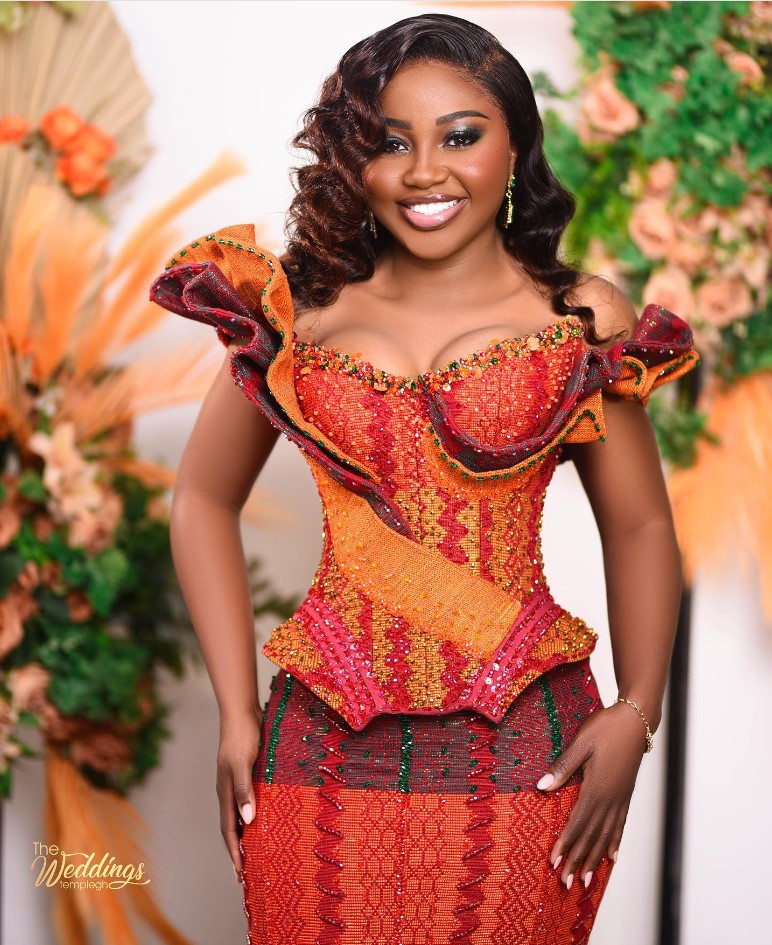
Bride’s Attire: A Symphony of Tradition and Elegance
Ghanaian brides typically wear elaborately embroidered Kente or other colorful fabrics, reflecting the nation’s rich cultural heritage. Gold jewelry, intricate beadwork, and symbolic motifs add to the regal and elegant look. For the Ghanaian bride, the wedding attire is more than just a dress; it is a manifestation of cultural pride and personal style.
Modern inspirations have given rise to contemporary wedding gown styles in recent years, which elegantly combine tradition and cutting-edge flair.
The bride’s clothing tells a story visually by signifying her ancestry, her family, and the start of a new chapter.
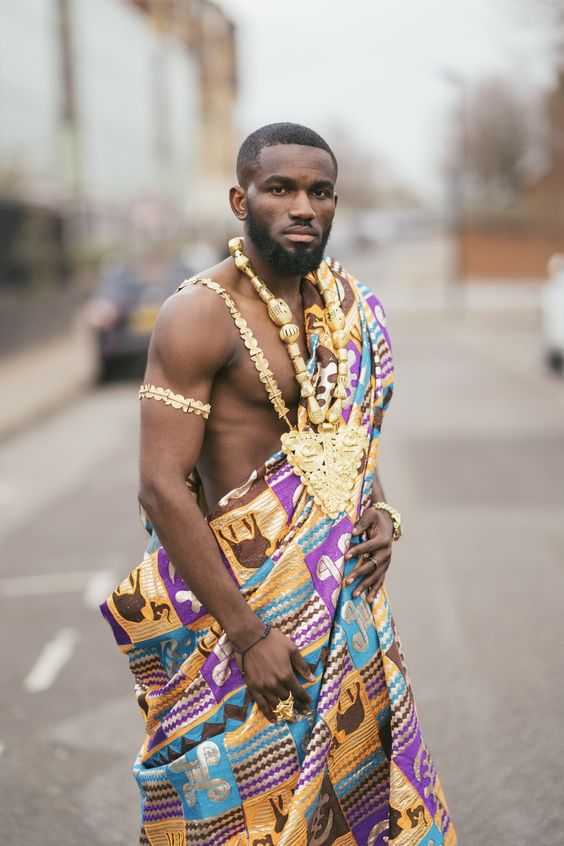
Groom’s Attire for Ghanaian Traditional Weddings
The groom’s attire at a Ghanaian wedding is a harmonious blend of tradition and contemporary flair.
Traditional Ghanaian grooms may opt for clothes made from the same fabric as that of the bride in the following styles:
- Batakari: This is a loose-fitting broad smock worn by men of certain ethnic groups in Ghana with intricate embroidery, complemented by Kente accessories.
- Agbada: This is a flowing outfit that resembles a gown, worn with trousers and a matching cap.
Alternatively, modern grooms might choose a tailored suit in vibrant colors, paying homage to tradition with subtle cultural elements like Kente lapel pins or cufflinks.
The groom’s outfit, like the bride’s, is a statement of identity, reflecting his connection to cultural roots while embracing the evolution of wedding fashion.
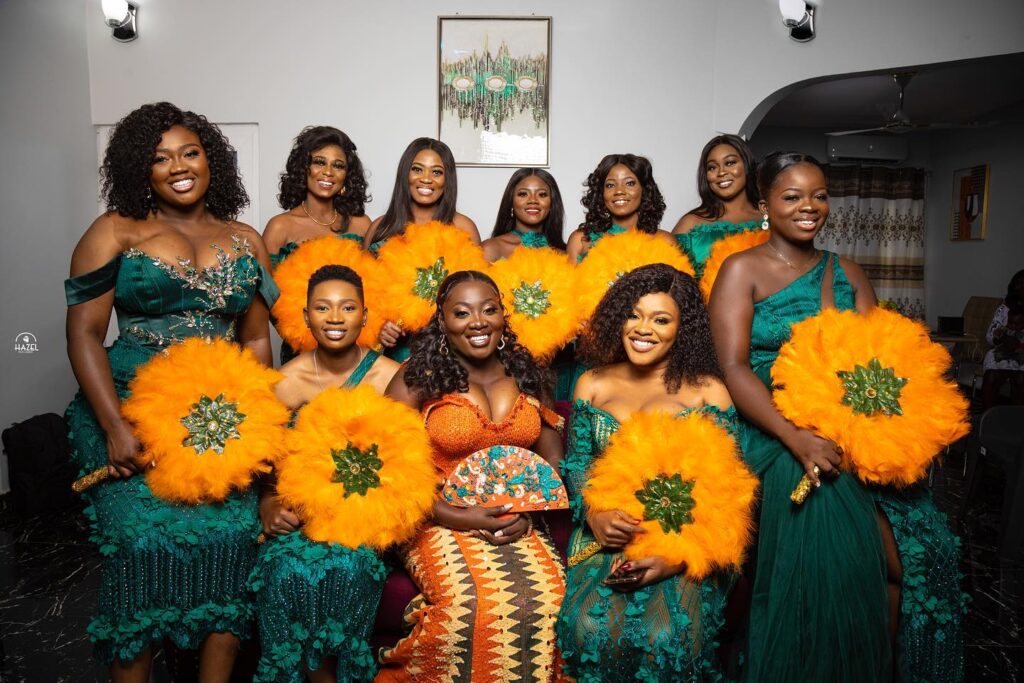
Ghana Traditional Wedding Bridesmaids
Bridesmaids play an important role in any wedding, as they support the bride and participate actively in all the wedding rituals. As such, they also have to look good!
Below are some elements of their outfits.
- Their outfits are made from Kente cloth.
- The colors that their outfits are made from must match the overall color scheme of the wedding.
- In some cases, each bridesmaid wears a duku (headscarf).
- The bridesmaids all wear traditional beaded jewelry matching the color scheme.
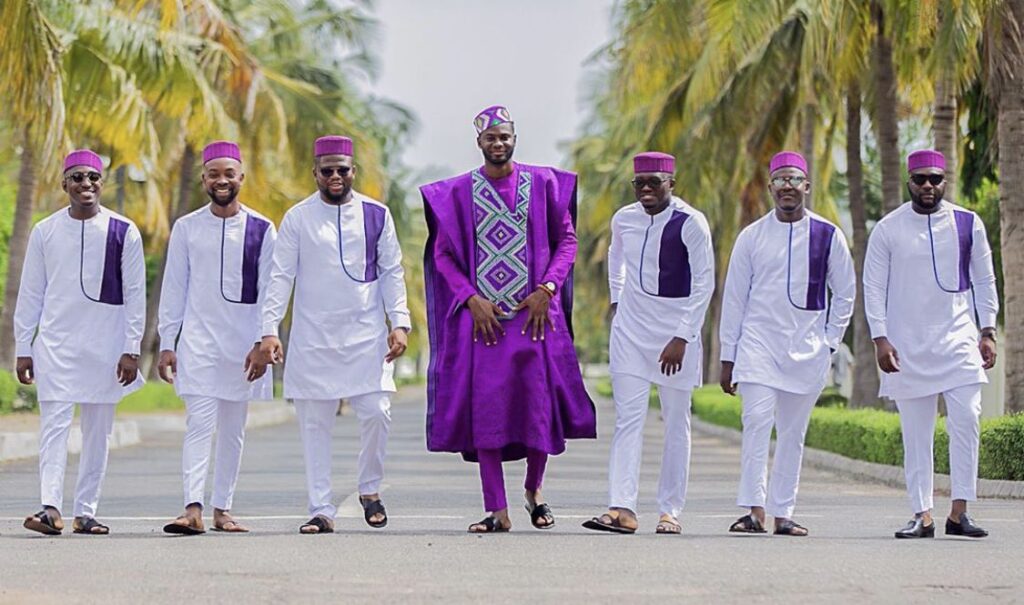
Ghana Traditional Wedding Groomsmen
In Ghanaian traditional weddings, the groomsmen all have roles to play. Some of these include supporting the groom and participating in the rituals.
Some characteristics of their outfits include:
- Smocks, shirts, or tunics made from Kente cloth.
- Attire that matches what the groom is wearing.
- Hats or caps that match their outfits and bear cultural significance.
- Traditional necklaces and bracelets.
Guests Outfits at Traditional Weddings in Ghana: Colors and Styles
Ghanaian wedding guests contribute to the visual spectacle with a kaleidoscope of colors and diverse styles.
How do the wedding guests at Ghana’s traditional weddings dress up for the event? For guests attending a Ghanaian traditional wedding, any formal attire is appropriate.
You can choose kente cloth in colors that represent good tidings for the couple, or you can just choose a brightly colored and ornately designed outfit that will fit right in with the theme. If you’re unsure, ask someone at the wedding party for their advice.
Women often showcase the beauty of traditional African prints, including Ankara and other indigenous fabrics, while men may don richly patterned Kente or opt for contemporary suits with cultural accessories.
The significance lies in the collective celebration of diversity, as guests honor the couple and the cultural mosaic of Ghana through their choice of attire. Wedding ceremonies become a canvas of colors, patterns, and styles that reflect the unity of diversity, creating a visually striking and harmonious atmosphere.
Women
- Kente dresses
- Matching head wraps
- Beaded Jewelry
- Aso Ebi (a specific fabric selected by the couple for all their attendees)
- Boubou dresses
Men
- Kente cloth outfits
- Agbada (a flowing 2-piece outfit)
- Dashiki (a loose-fitting tunic)
- Matching caps or hats
- Beaded necklaces
- Embroidered outfits
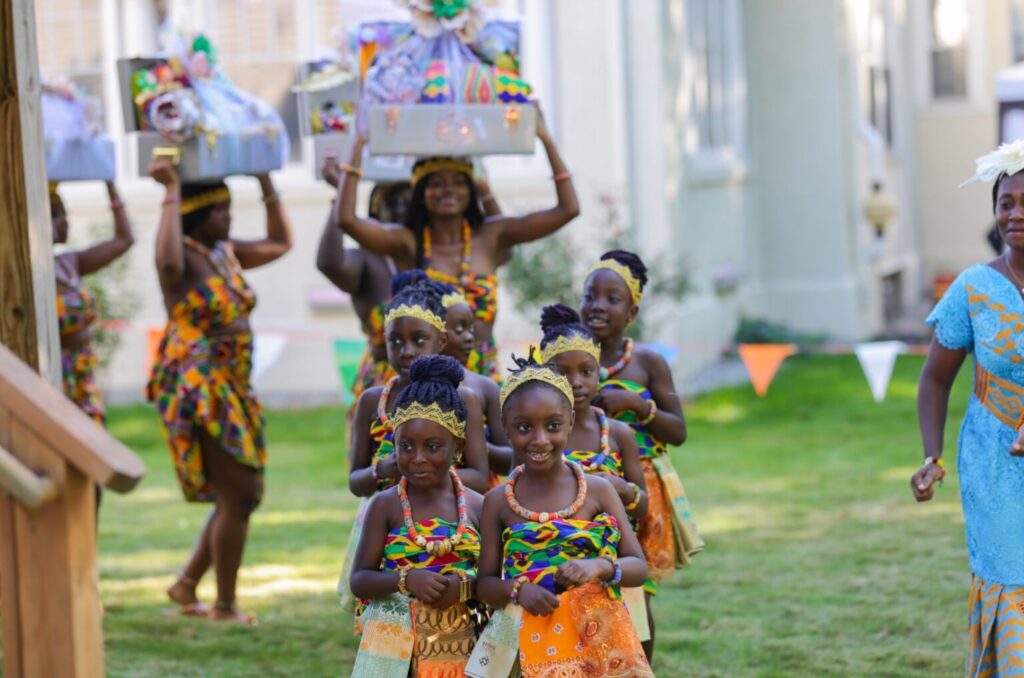
Ghanaian Wedding Ceremony Traditions
Typically, the marriage ceremony will take place at the bride’s home or any other suitable venue. Live music performed by traditional “adowa” groups or bands will be played before the ceremony.
During the ceremony itself, members of both families will sit across from one another, and spokespersons assigned to each party will engage in friendly conversation. The bride’s family will be seated to welcome the groom and his family, who come in bearing the items on the marriage list, or “aye-yo-dee” gifts; a long line of family members comes with gifts in their hands or on their heads.
Ghanaian wedding customs include the bride offering her consent three times when asked for her hand in marriage as a sign that she has not been coerced into marriage; although this tradition predates modern weddings, it is still observed today. Following her acceptance, the bride is introduced to the groom’s family.
In Ghanaian tradition, the marriage is considered sealed when the groom offers the father drinks during the wedding, such as palm wine or Schnapps. This custom is known as Tiri Nasa.
Ghanaian Wedding Reception Traditions
Following the traditional and sometimes the church service ceremony, there will be a reception with food, music, and dancing where guests can dance to traditional Ghanaian music, savor local cuisine, and enjoy each other’s company as they celebrate the newlyweds.
The bride and groom will go around greeting and thanking each of their guests for attending, and personalized wedding favors like chocolates, mugs, or pens are given out.
The groomsmen or other guests will “compete” to throw money at the couple at the end of the song during their first dance; this helps to provide the newlyweds with funds for their new life while also offering a lighthearted and friendly competition for the guests. The couple will cut their cake and deliver speeches; occasionally, guests who have traveled a distance will be offered separate events following the wedding, like a luncheon.
Conclusion
Ultimately, the clothes worn at a typical Ghanaian wedding represent more than just style; they are a symbol of pride in one’s culture, individuality, and the dynamic nature of modern customs. From the bride’s majestic dress to the groom’s blend of tradition and style and the colorful variety of guest clothes, every ensemble contributes to telling the distinct tale of love, history, and celebration.

